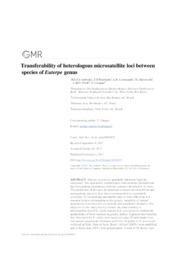Transferability of heterologous microsatellite loci between species of Euterpe genus.
Transferability of heterologous microsatellite loci between species of Euterpe genus.
Author(s): AZÊVEDO, H. F.; BENVINDO, F. D.; CAVALCANTE, L. N.; HAVERROTH, M.; WADT, L. H. de O.; CAMPOS, T. de
Summary: Euterpe precatoria, popularly known as "açaí-do-amazonas", has agronomic, technological and economic potential and has been gaining prominence with the commercialization of its fruits. The production of this açaí-do-amazonas is based on extractivism and management practices have been recommended for sustainable collection. To recommend sustainable rates of fruit collection, it is essential to have information on the genetic variability of natural populations to monitor the recruitment and population dynamics. The objective of this study was to evaluate the transferability of microsatellite loci of E. edulis species to E. precatoria to confirm the applicability of these markers in genetic studies. Eighteen microsatellite loci developed for E. edulis were analyzed using 20 individuals from two natural populations (Formoso and Novo Segredo) of E. precatoria collected at Feijó, State of Acre, Brazil. All loci (100%) were amplified, and of these, nine (50%) were polymorphic. A total of 29 alleles were found in the Novo Segredo population, and 27 alleles were found in the Formoso population, ranging from two to five alleles per locus, with a mean of three alleles per locus. The expected heterozygosity in the Formoso population varied from 0.100 to 0.668, with an average of 0.421. In the Novo Segredo population, a variation between 0.100 and 0.710, with a mean of 0.418, was found. The observed heterozygosity values ranged from 0.100 to 0.800, with averages of 0.333 and 0.267 for Formoso and Novo Segredo, respectively. This set of markers will support further studies on the molecular characterization of the natural populations of E. precatoria and assist with the recommendation of sustainable management practices and strategies for the conservation and genetic improvement of this species.
Publication year: 2017
Types of publication: Journal article
Unit: Embrapa Rondônia
Keywords: Acre, Amazonia Ocidental, Açaí, Dinámica poblacional, Dinâmica populacional, Ensayos de variedades, Feijó (AC), Fitomejoramiento, Formoso, Marcador microssatélite, Marcador molecular, Melhoramento genético vegetal, Novo Segredo, Repeticiones de microsatélite, Transferability, Transferibilidad, Transferibilidade, Variación genética, Variação Genética, Variedade, Western Amazon
Observation
Some of Embrapa's publications are published as ePub files. To read them, use or download one of the following free software options to your computer or mobile device. Android: Google Play Books; IOS: iBooks; Windows and Linux: Calibre.
Access other publications
Access the Agricultural Research Database (BDPA) to consult Embrapa's full library collection and records.
Visit Embrapa Bookstore to purchase books and other publications sold by Embrapa.

